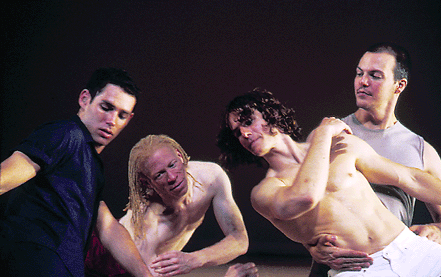Revelatory portraits test dancer’s skill and virtuosity
Terry Creach’s easygoing improvisational style feels like a Friday evening. The untangling of nerves gives reason to celebrate early. At Soho Joyce Thursday, November 16, Creach/Company performed three premieres and two dances from last year, beginning with the 2004 “You Go When You Can No Longer Stay,” a solo for Joseph Poulson. He seems the master of his naturally flowing organic movement; his fluid arms give the impression there isn’t a straight line in his body. A video image of Poulson moves behind the shadow he is creating on the cyclorama with his live dance. He’s beside himself, and has left an overwhelming burden with his virtual clone, by the magic of dance and Sue Rees’ video. Poulson is in white, adding an unearthly effect.
Karl Rogers and Keith Thompson dance the new “A Likeness,” but Creach’s choreography actually allows for their individuality. They begin in unison, then shift to solos in which Roger’s handsprings are so limpid and fleet you may blink and miss them. Thompson is more angular and slumps forward and backward while facing upstage with his feet planted and spread for maximum stability. Without flinching, he cuts the heel of his hand into the crook of his arm in a general “fuck you,” to the fourth wall of the white box stage. His dance is cool and it’s more about him. If these are portraits then Thompson’s is most revelatory.
Darrin Wright, Rogers, and Poulson dance “My Pleasure,” another premiere. Wright is the protagonist. A recorded spoken text is like his aural thought bubble. The incomplete and jumbled phrases or words are grumbles about people in general. A bit dazed and disaffected, his character reels about while Poulson and Rogers alternately stand to the side and watch him, or jostle him in acrobatic lifts like older brothers.
In a noble experiment Creach tests the value of the dancers’ skill and virtuosity. He taught four visual artist guests to perform his 2004 “Broken Hearts Club.” The audience laughs as the group actually looks like they are parodying Creach’s movement style. The talented, earnest amateurs create an artful divertissement. Anyone can do it but not with the same performative results. That is not to say that crossing media doesn’t work. Literature laureate Derek Wolcott currently has a solo show of paintings in SoHo. He says he approaches painting with “a devotion transferred from a different servitude.” In the case of dance, that servitude must be manifest in the body.
With understated superlative theatrical presence and toned bodies, the company dancers join us again for a final untitled premiere I’m tempted to call “Lean To.” This is choreography for the group in which poise and plastique play a central role. Their images are burned in white on the cyclorama and their shadows join the crowd. Creach uses the space of the stage imaginatively and efficiently with his small company, filling it with activity. Jane Shaw’s wonderful music helps create the buoyant mood with low-level percussive and sampled sound like the rushing water for Wright’s opening solo in this piece. Wright comes into his own under Creach’s direction.
The dancers’ light contact punctuates; small shoves and pushes with a foot or palm set directions. The company holds hands, running in a circular pattern, each turns and poses in skewed arabesques. They move sideways—in unison, alone, or supported—not falling or lunging, but leaning to the floor. The choreography is pleasingly loose and relaxed and the dancers’ steps are borrowed from each other as well as from different dance genres. Thompson does a jazzy solo. Wright crosses his arms in a sort of demi-expletive. On him it’s even less of a social sign, but one of his own design and evolving purpose. The four, expressionlessly workmanlike, line up along the left and look upstage, right arms raised and pointing out—a bow of solidarity.
gaycitynews.com


































